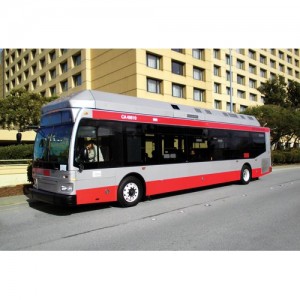
The San Francisco Municipal Transportation Agency (SFMTA) manages and operates the surface transportation network in San Francisco including: pedestrian, bicycle, transit, traffic, parking, and taxi regulation. The San Francisco Municipal Railway (Muni), the largest division within the SFMTA, handles transit operation and maintenance for the city’s bus, light rail, trolley, historic street cars, and cable car fleets, as well as facility maintenance. Muni is the oldest public transportation agency in the United States, serving more than 200 million customers per year with the country’s most diverse fleet of vehicles.
The SFMTA is committed to reducing overall carbon emissions, especially for its vehicle fleet. Although more than half of the Muni fleet is zero-emission, the agency is actively working to further reduce fossil fuel use and emissions. The SFMTA Clean Air Plan – Zero Emissions 2020 sets a goal of an all-electric fleet by 2020.
The Bus 2010 project targets FTA’s NFCBP objectives of facilitating commercially viable fuel cell bus technologies. BAE Systems has teamed with CALSTART and the SFMTA to develop and demonstrate the bus in a challenging transit service. Bus 2010 is considered an evolutionary approach because it combines a smaller, low-cost fuel cell system with a commercial diesel-hybrid propulsion system. There are several potential advantages to this approach:
- The primary fuel is diesel so that the bus can operate in areas where hydrogen supply is limited.
- The SFMTA has a fleet of BAE Systems hybrid buses, so the staff is already familiar with the majority of the system.
- Using a small fuel cell reduces the overall cost of the advanced technology bus, which could enable more transit agencies to adopt the technology and to begin the learning curve to full hydrogen fuel cell buses in the future.
Based on its commercial hybrid drive technology, BAE Systems’ Bus 2010 blends energy from the diesel engine and the fuel cell to provide a partial zero-emission bus with improved fuel economy. Bus 2010 also incorporates a fully electric accessory package that eliminates engine belt driven components allowing operation with the diesel engine off. Like a conventional BAE Systems hybrid bus, the design utilizes nano-phosphate lithium-ion battery technology to capture and reuse braking energy. Primary power is provided by a diesel engine and two Hydrogenics fuel cells connected in series. A DC/DC converter boosts the output voltage to allow the fuel cells to provide the first 24 kW of power for both propulsion and accessory operation. Under the right conditions, the bus can operate in full zero-emission mode with the engine off. When the power demand exceeds the maximum available fuel cell power, the diesel engine starts and provides additional power. The system can also operate on the diesel engine only.